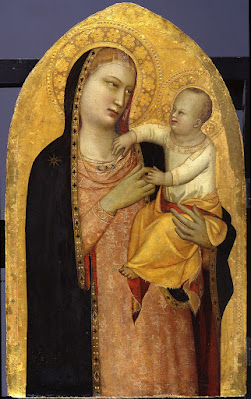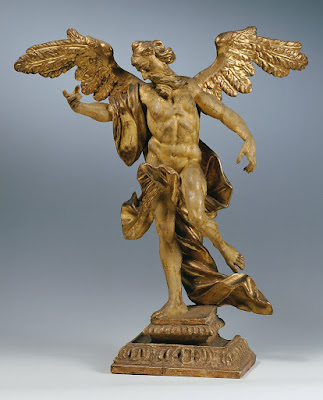 |
| Gustav Klimt Judith with the Head of Holofernes 1901 oil paint and gold leaf on canvas Belvedere Museum, Vienna |
-National-Gallery-of-Art-Washington-DC.jpg) |
| Paolo Veneziano The Crucifixion ca. 1340-45 tempera and gold leaf on panel National Gallery of Art, Washington DC |
-Farnese-Hercules-(verso)-AD-282-283-gold-Museumslandschaft-Hessen-Kassel.jpg) |
| Roman Empire Aureus of Emperor Carus AD 282-283 gold Museumslandschaft Hessen Kassel |
 |
| Einar Sigstad Man with Ball 1993 oil on canvas Nasjonalmuseet, Oslo |
-Hercules-brandishing-Club-c1600-gilt-bronze-statuette-Victoria-&-Albert-Museum-London.jpg) |
| Ciechanowiecki Master Hercules ca. 1600 gilt-bronze statuette Victoria & Albert Museum, London |
 |
| Anonymous Netherlandish Artist The Crucifixion ca. 1420 tempera and gold leaf on panel Kunsthaus Zürich |
-Mus%C3%A9e-d'Art-Classique-de-Mougins.jpg) |
| Roman Empire Mercury AD 175-200 gilded-bronze statuette Musée d'Art Classique de Mougins |
-1961-gold-leaf-on-panel-Moderna-Museet-Stockholm.jpeg) |
| Yves Klein Untitled (Monogold MG-24) 1961 gold leaf on panel Moderna Museet, Stockholm |
-Museum-of-Fine-Arts-Boston.jpg) |
| Gherardo Starnina St Stephen ca. 1410 tempera and gold leaf on panel (altarpiece fragment) Museum of Fine Arts, Boston |
 |
| Maso di Bianco Virgin and Child ca. 1335-36 tempera and gold leaf on panel Gemäldegalerie, Staatliche Museen zu Berlin |
 |
| Roman Empire Apollo painted plaster cast (20th century) imitating gilt bronze after marble original (AD 90-130) Museumslandschaft Hessen Kassel |
 |
| Ludwig Kainzbauer The Gold Cabinet in the Upper Belvedere 1885 oil on canvas Belvedere Museum, Vienna |
 |
| Anonymous Austrian Artist Angel ca. 1750 giltwood statuette Belvedere Museum, Vienna |
 |
| Grifo di Tancredi Christ Blessing ca. 1310 tempera on panel National Gallery of Art, Washington DC |
 |
| Kjell Nupen Silence under Water 2007 oil paint and gold leaf on canvas Stortingets Kunstsamling, Oslo |
-Museumslandschaft-Hessen-Kassel.jpg) |
| Ancient Greek Culture in Asia Minor Earrings 6th-5th century BC gold Museumslandschaft Hessen Kassel |
The rest departed, each to his own home, including Arsake, though she found it hard to tear herself away and turned back many times and loitered in the temple, pretending to pay further pious homage to the goddess. But depart she eventually did, with many a backward glance at Theagenes as long as he remained in view. When she reached the royal court, she rushed straight to her chamber and hurled herself onto her bed, where she lay fully clothed in silent misery. She was a woman generally addicted to ignoble pleasure, but now her passion was fired as never before by Theagenes' peerless beauty, before which everything else in her experience paled into insignificance. All night she lay there, ceaselessly tossing from side to side, ceaselessly sighing from the depths of her being: one moment she would sit bolt upright, the next slump back on the bedclothes; she would remove part of her clothing and then suddenly collapse back on her bed, or, occasionally, summon a maidservant for no apparent reason and then send her away again without asking her to do anything.*
*Arsake's restless sleeplessness is one of the familiar symptoms of love in literature, but Heliodorus also wishes to call to mind Homer's picture of Achilles grieving sleeplessly for Patroclus:
nor did sleep
who subdues all come over him, but he tossed from one side to the other
in longing for Patroclus . . . he let fall the swelling tears, lying
sometimes along his side, sometimes on his back, and now again
prone on his face, then he would stand upright.
– Heliodorus, from The Aethiopica, or, Theagenes and Charikleia (3rd or 4th century AD), translated from Greek by J.R. Morgan (1989)